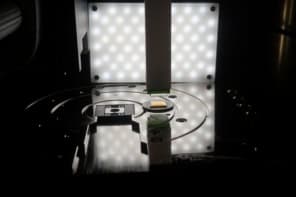Researchers in Europe have developed a new technique that allows them to study the motion of electrons in solids on timescales less than 100 attoseconds (10-16s). In doing so, the team was able to measure how long it takes for electrons to reach the surface of a sample after they have been excited by laser light. The photoemission spectroscopy experiment reveals that electrons from the conduction band emerge with twice the velocity of bound electrons (Nature 449 1029).
The classical Bohr theory of the atom predicts that an electron takes about 150 attoseconds (as) to “orbit” a hydrogen atom. The atomic nuclei move much more slowly, which means that attosecond spectroscopy can be used to study electron behaviour while the atoms are essentially frozen in time.
While attosecond spectroscopy of atomic gases have been possible for some time, similar experiments on solids had been limited to about 10 fs (10-14s) resolution. Now, Ferenc Krausz and colleagues at the Max Planck Institute for Quantum Optics in Garching, Germany along with physicists at universities in Germany, Austria and Spain have worked out a way to do attosecond spectroscopy on electrons emitted from the surface of a solid.
The technique uses a 300-as pulse of extreme ultraviolet light (XUV), which enters the sample and ejects electrons via the photoelectric effect. At the same time a much longer pulse of infrared light is reflected from the surface of the sample. Once ejected, the electrons are accelerated by the infrared light towards a time-of-flight detector positioned over the sample. This measures the arrival times of the electrons to attosecond accuracy.
The team proved the effectiveness of the technique by studying the time it takes for electrons to be ejected from a tungsten sample after absorbing a XUV photon. They discovered that electrons escaped the material in two distinct groups separated in time by about 110 as. By measuring the kinetic energy of electrons in each group, Krausz and colleagues concluded that first to leave were conduction electrons, followed by electrons that had been in a bound f-state.
According to the team, about 20 as of this delay arises because excited bound electrons can travel further through tungsten than excited conduction electrons, and therefore the bound electrons are likely to have come from deeper in the sample. The remaining 90 as delay corresponds to the expected difference in kinetic energy between bound and conduction electrons that have each absorbed one XUV photon.
The attosecond timescale is the absolute limit on how fast an electronic device could operate. As a result tiny electronic circuits a few atoms in size could, in principle, switch electric currents at petahertz frequencies (1015), which is nearly a million times faster than processors today. However, very little is currently known about how electrons would actually move through such circuits – which is why Krausz and colleagues believe their new technique will play a valuable role in the development of future electronics technologies.


